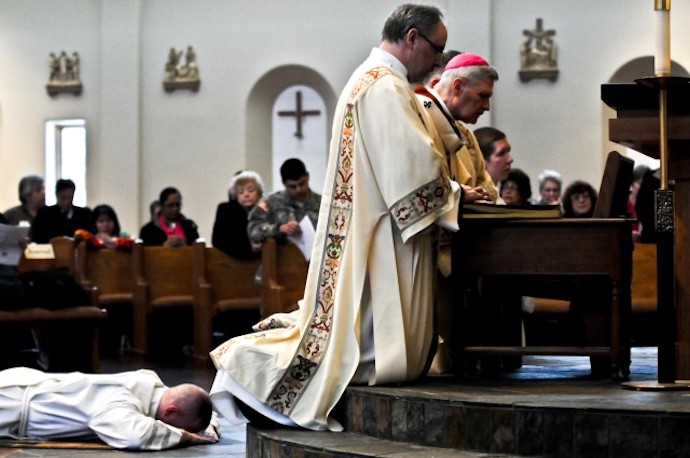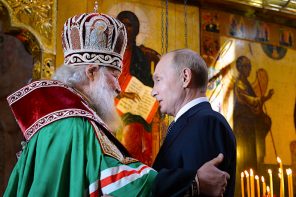The recent announcement by Pope Francis that he will not allow married men to be ordained to the priesthood in the Amazon as recommended by the recent Amazon Synod has caused a flurry of conversation and controversy. While those on both sides of the “married priest” debate have a tendency to wrap themselves in the robes of tradition, the real history of mandated clerical celibacy is much more complicated, demonstrating a variety of beliefs and practices across time and place.
What’s most clear in the earliest history of Christianity, including within the Scripture, is that the Christian reverence for celibacy begins with Paul of Tarsus. Fourteen of the New Testament’s twenty-seven books are traditionally attributed to him, though he likely only wrote seven himself (the other seven are likely the products of his students). The “hellenized” son of a Jewish mother and Roman father, Paul (born “Saul”) lived at the crossroads of the great cultural forces of his day. Devout and pious, by his own account he was transformed from a zealous persecutor of Christians to the architect of much of Christianity as it transformed from a small tangentially Jewish sect into a major religious and philosophical movement.
It’s impossible to wrestle with most of contemporary Christianity’s most vitriolic controversies without confronting Paul. Because it is Paul’s views on sex and gender that shaped traditional Christian understanding. It’s in the writings of Paul that conservative Christians find most of the scriptural backing for the subservience of women, the immorality of homosexuality, and, indeed, the call for clerical (and lay!) celibacy.
In the second and third centuries, Paul was joined by some early church fathers such as Tertullian in his veneration of celibacy, both clerical and lay. However, during the same period, there is ample historical evidence for the existence of married clerics, including bishops, even in the Christian West, and it remains unclear if these married priest and bishops had sexual relations within the context of their marriages after ordination.
It’s not until 306 at the Council of Elvira that any written prohibition is issued against sexual conduct by clergy, and importantly, the Council imagines that clergy may continue within preexisting marriages, so long as those marriages do not include sex from the point of ordination onward. Canon 33 of the Council of Elvira orders that all ordained clergy “abstain completely from sexual intercourse with their wives and from the procreation of children.” The canon asserts that those who fail to abstain be stripped of their ordination. Similar canonical decrees continued to be issued throughout the 4th century; however, it’s clear that while held up as the ideal, sexual continence among the clergy was never a universal practice, nor even expectation, and local customs continued to differ widely.
Moreover, even by the 5th century, it was clear that the idea that sexual relations, even within marriage, were incompatible with ordained ministry was an idea and practice much more prevalent in the Western Church (i.e. those Latin territories directly under the Bishop of Rome) than in the Greek-speaking East. By 692, the Quinisext Council essentially formalized this difference and set out what continues to be the Eastern Orthodox practice to this day: Married men may be ordained as deacons and priests after their marriage. However, men who are ordained before marriage may never do so. Bishops are chosen from the ranks of the celibate clergy.
The Eastern Orthodox and Roman Catholic Churches formally divided in 1053 which coincided with a period of reforms in the Roman Church known as the Gregorian Reforms. In connection with his attempt to establish papal supremacy, Pope Gregory VII took up a campaign against married clergy. In 1074, he issued a papal encyclical essentially stripping episcopal authority from bishops who allowed married priests. The next year, he issued a decree depriving married priests of their incomes. While these papal actions initially met with significant opposition, they were ultimately successful. The greatest indication of this success is that a century later, both the First and Second Lateran Council issued the most widespread and harshest decrees against married clergy in Church history with little objection. With the Eastern churches gone and Western opposition silenced, clerical celibacy became the unquestioned practice of the Roman Catholic Church.
It was not until the Protestant Reformation, beginning in the 16th century, that the practice would be questioned. The Reformers saw clerical celibacy as unsupported by the New Testament and saw its abolition as one of the key areas in need of reform. In opposition to the longstanding practice of both the Western and Eastern churches, Protestant reformers permitted unmarried clergyman to marry after ordination and for bishops to be chosen from among married churchmen. The re-introduction of married priests to the West, as well as the innovation of married bishops, became such a central point of Protestant theology and reform that the rejection of these practices was among the core proclamations of the Council of Trent, often described as “the embodiment of the Counter-Reformation.”
And it is arguably through the Council of Trent that clerical celibacy became a marker of Catholic identity. But this role has not prevented it from being a contested point within Catholicism since the middle of the 20th century, as a steep decline in men entering the priesthood has met with increasingly vocal questions as to whether the centuries-old ban should be maintained. Many advocates for allowing married priests within the Catholic Church point to the Eastern Orthodox practice and even argue that allowing for married clerics would be a step toward healing the millenia-old division between Christendom’s two great halves.
Moreover, advocates of allowing married clergy, point out that even today there are married priests serving under the jurisdiction of Rome. Byzantine Catholics, Eastern Orthodox Christians who have entered into communion with Rome, maintain the Eastern Orthodox practice around clerical celibacy, allowing married men to be ordained to the diaconate and priesthood, though not the episcopacy (i.e. bishop). The Catholic Church also allows married clergymen who convert to Catholicism to, on a case-by-case basis, be ordained into the Catholic priesthood. This includes those converting as part of Personal Ordinariate of the Chair of St. Peter, a jurisdictional structure created in 2012 for former Anglican communities and clergy who convert to Catholicism.
In short, in recent centuries, the Vatican has allowed married clergy in instances where married clerics are part of local custom. This practice, perhaps a bit ironically, really does harken back to the earliest centuries of Christianity and the first debates on whether ordination and marriage were compatible states.
Certainly, the recommendation of the Amazonian Synod to introduce married clergy into the Amazonian region was different than the cases mentioned above. But it’s not that different. And Pope Francis’s decision to not implement the suggested reform is telling. In some ways, it puts the Pope at odds with the reform-minded and progressive factions within the Church that have been his greatest allies, and it’s unlikely that this single act of conservatism will win him many friends among traditionalists who find him generally unacceptable. What is clear is that the issue of clerical celibacy has never been a clear one–a state that’s unlikely to change anytime soon.





